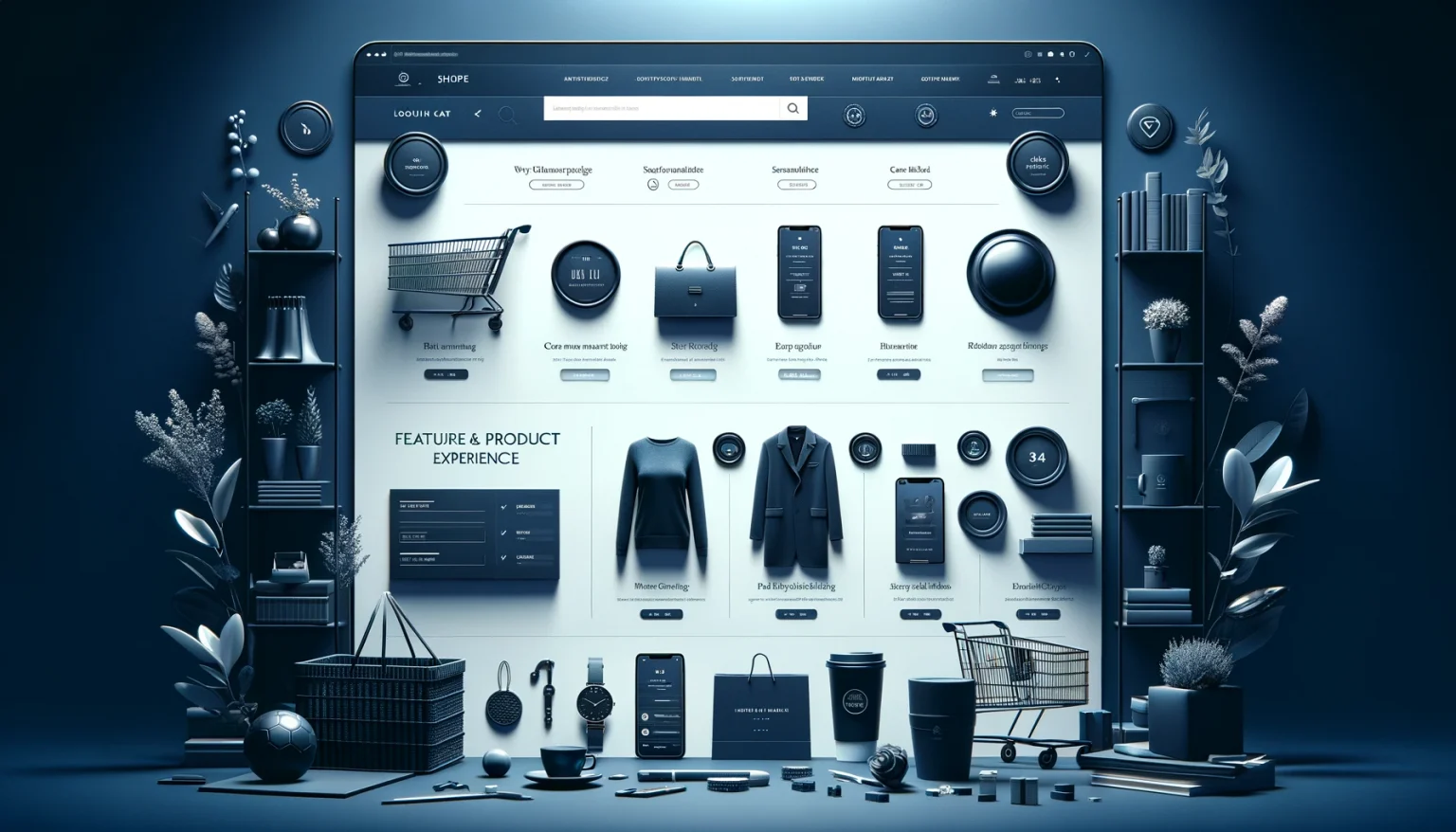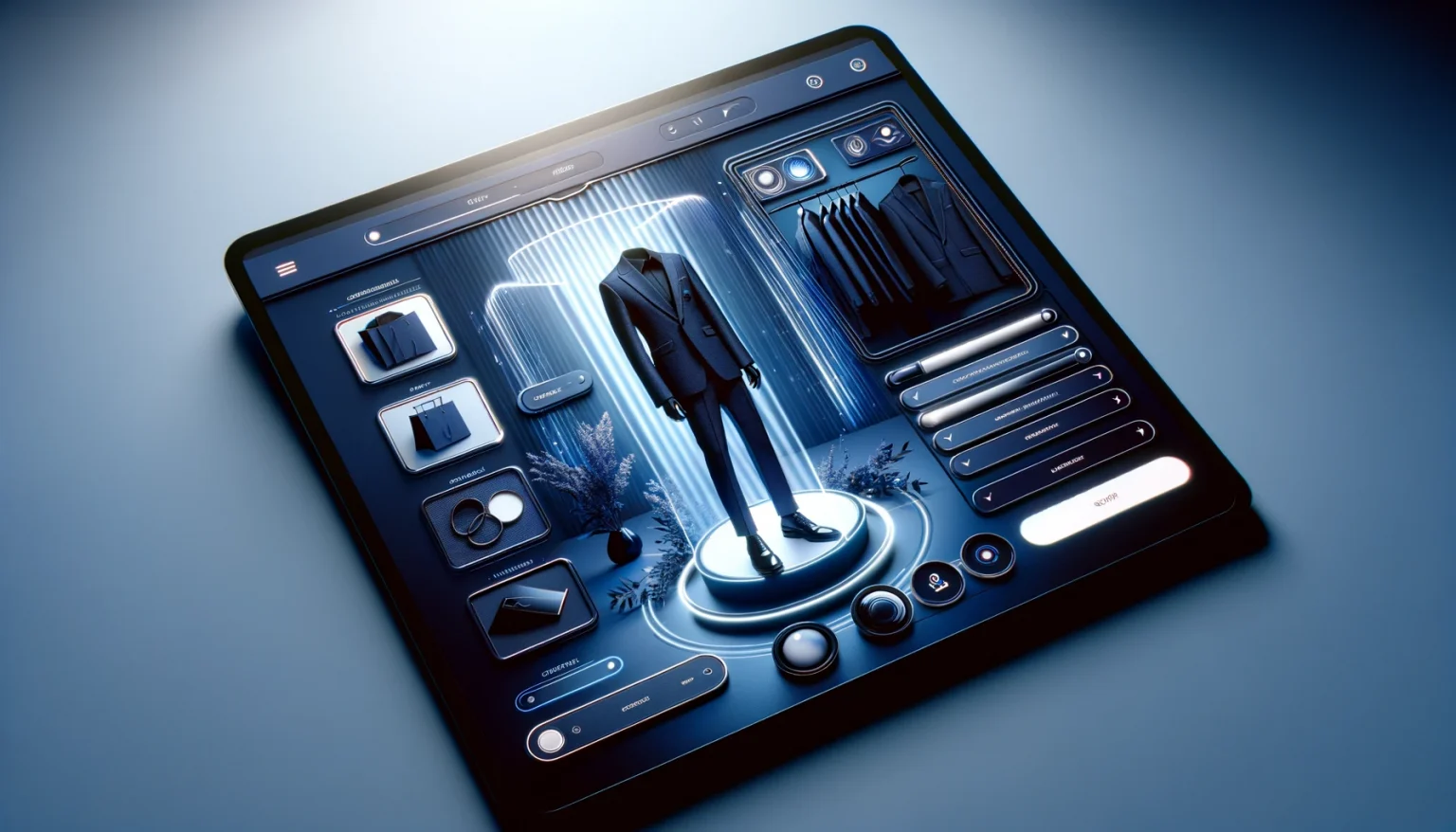Business Developer | Nicolai Errebo Birch 💻
UX ECOMMERCE: UX DESIGN & WEB DEVELOPMENT



In an era where digital commerce is rapidly evolving, the design of a webshop is not just about aesthetics but about creating a seamless and engaging user experience. This case study presents a fictional scenario of designing a UX ecommerce webshop, focusing on a user-centric approach. We will explore each phase of the design process, integrating principles of user experience (UX), supported by academic research and practical methodologies. This comprehensive approach ensures that the webshop not only attracts customers but also retains them through a satisfying user experience.
Role : UX Designer & Web Developer
Approach : The Design Thinking Process
Client : Fictional (showcase)
Year : 2023
Category : Webshop
Toolkit :
Interview users
Analyze feedback
Map findings
Identify pain points
Prioritize features
Set UX goals
Brainstorm features
Explore layouts
Conceptualize navigation
Low-fidelity prototypes
Interactive mockups
Iterate designs
Usability testing
Analyze interactions
Finalize design
Deep Dive into User Understanding
The Empathize phase lays the groundwork for user-centric design in ecommerce, involving deep audience understanding through methods like interviews and surveys. This stage uncovers nuanced user needs and preferences in ecommerce, as noted by Yoo et al. (2023) and Arshad, Yasir, and Shakeel (2021), who highlight its impact on interface design and web usability. Understanding ecommerce users involves exploring their daily lives, shopping habits, and tech interactions. It’s about comprehending not just what users need, but why they need it, how they go about fulfilling those needs, and what barriers they face in the process. This deep understanding is crucial for creating a webshop that is not only functional but also emotionally resonant with its users.
Ethnographic studies, for instance, can provide invaluable insights into the real-world contexts in which users interact with ecommerce platforms. Observing users in their natural environments helps in identifying unarticulated needs and pain points that might not be evident in more structured research settings. This method can reveal how users’ attitudes towards shopping and technology vary across different cultures and demographics, providing a more holistic view of the target market. Behavioral analysis, on the other hand, involves studying the actual behavior of users on existing ecommerce platforms. This can include analysis of website traffic, user navigation patterns, and interaction with various elements of the site. Such data-driven insights can help in identifying trends and patterns in user behavior, which can be crucial for designing an intuitive and efficient user interface.
The goal of the Empathize phase is to gather a rich tapestry of data, both qualitative and quantitative, to form a comprehensive picture of the user’s world. This data serves as the bedrock upon which all subsequent design decisions are made. It ensures that the design team is not just making assumptions about what users want, but are actually basing their decisions on real, actionable insights.
Template Suggestion: User Research Report Template. This template organizes and presents user research for commerce sites, including demographics, behaviors, and feedback. It should serve as a reference document throughout the design process. The template should be structured in a way that it not only presents raw data but also offers insights and interpretations of that data. It should include sections for different types of research methods used, key findings from each method, and how these findings will influence the design of the webshop. The template should also include visual aids like graphs, charts, and user personas to make the data more accessible and understandable.
Clarifying and Prioritizing User Needs
After gathering a wealth of user insights in the ecommerce space, the Define phase focuses on distilling this information into clear, actionable insights. This involves analyzing and synthesizing the data to identify key user pain points, desires, and behaviors. Maulana and Rosyidah (2022) highlight how this step is critical in ecommerce, as it ensures that the solutions are directly addressing the real needs of users. Abuzeid and Ibrahim (2017) also discuss the importance of user experience design criteria in ecommerce, underscoring the global applicability of these principles.
In this phase, the data collected during the Empathize phase is broken down and examined to uncover underlying patterns and themes. This process often involves creating affinity diagrams, user personas, and customer journey maps. These tools help in visualizing the user’s experience and identifying areas where the webshop can be improved or where new features can be introduced.
For instance, user personas are fictional characters created based on the research data. They represent different segments of the webshop’s target audience and help in understanding the diverse needs and motivations of these segments. Customer journey maps, on the other hand, illustrate the steps users take when interacting with the ecommerce platform. They help in identifying pain points and moments of delight in the user’s journey. This understanding is crucial for designing a webshop that provides a seamless and enjoyable shopping experience.
The outcome of the Define phase is a set of well-defined problem statements and user needs that will direct the subsequent design efforts. These problem statements act as a guide, ensuring that the design process remains focused on addressing the most critical user needs. They also help in setting clear goals for the project, which can be crucial for measuring its success post-launch.
Template Suggestion: User Journey Template – This template is designed to map out the user journey specifically for a webshop, detailing the steps a user takes from initial contact to post-purchase interactions. It should help in visualizing the path a customer follows, including their experiences and emotions at each stage. The template should include sections for each identified user persona, outlining their journey through the webshop. This includes key touchpoints, potential pain points, and opportunities for enhancing the user experience.
The user journey map should also highlight moments of truth, where the user’s impression of the webshop is significantly impacted. Additionally, the template should guide the team in identifying areas for improvement and innovation, ensuring that the webshop is not only functional but also emotionally engaging and aligned with the users’ needs and expectations. This approach will provide a clear direction for the ideation phase, focusing on creating a seamless and satisfying user experience.
Exploring a Spectrum of Creative Solutions
In the Ideate phase, the focus shifts to creative problem-solving in the context of UX ecommerce. This stage is all about generating a wide range of ideas, from incremental improvements to radical innovations, to address the defined user needs. The key here is to foster an environment of creativity and open-mindedness, where no idea is too far-fetched. Dinata et al. (2023) discuss the role of creative thinking in enhancing the user experience in ecommerce, suggesting that innovative design solutions can significantly differentiate a webshop in a crowded market. Gunawan et al. (2021) also emphasize the impact of user interface design on user experience in ecommerce, highlighting the need for creative and user-friendly UI solutions.
This phase should encourage divergent thinking, allowing the team to explore a broad spectrum of potential solutions. Brainstorming sessions, mind mapping, and sketching are commonly used techniques in this phase. These methods help in unleashing creativity and exploring various possibilities without the constraints of feasibility and practicality at this stage. For instance, brainstorming sessions can be structured to focus on specific aspects of the ecommerce experience, such as navigation, product display, or checkout process. Team members can be encouraged to think outside the box and propose ideas that might seem unconventional.
Mind mapping is another effective tool in the Ideate phase. It allows for the visual organization of ideas, showing the relationships between different concepts. This can be particularly useful in understanding how various elements of the webshop interface can work together to create a cohesive and intuitive user experience.
This template aids in documenting webshop brainstorming, organizing ideas by themes, feasibility, and impact. It should also include a mechanism for narrowing down ideas to the most promising ones for prototyping. The template should provide guidelines for conducting effective brainstorming sessions, including tips for encouraging creative thinking and ensuring that all team members can contribute their ideas. It should also include a section for mind mapping, helping in organizing and visualizing the relationships between different ideas. Additionally, the template should offer a framework for sketching and visualizing ideas, with examples of wireframes and interface layouts.
Bringing Ideas to Life through Iterative Design
Prototyping in the context of UX ecommerce is where ideas start taking a tangible form. This phase involves creating mock-ups or models of the webshop, ranging from simple sketches to interactive digital prototypes. Snyder (2003) advocates for rapid prototyping methods, which allow for quick iterations and refinements based on feedback. This phase is crucial for experimenting with different design elements, such as layout, navigation, and visual style, and assessing their effectiveness in fulfilling user needs and enhancing the overall user experience.
Rapid prototyping is particularly beneficial in ecommerce as it allows designers to quickly test and iterate on their ideas. This approach can lead to more innovative and user-friendly designs, as it provides the flexibility to experiment with different concepts without a significant investment of time and resources. For instance, a prototype might explore an unconventional navigation layout or an interactive product display feature. By testing these ideas early in the design process, it becomes easier to identify the most promising solutions and refine them further.
Interactive digital prototypes are an essential tool in this phase. They provide a realistic representation of how the final webshop will look and function, allowing for more accurate testing and feedback. These prototypes can be used to conduct usability tests, gather user feedback, and identify areas for improvement. The feedback collected during this phase is invaluable, as it provides direct insights into the user’s experience and preferences.
The prototyping phase also involves collaboration between different team members, including designers, developers, and stakeholders. This collaboration is crucial for ensuring that the prototypes are not only visually appealing but also technically feasible and aligned with the business objectives. Regular meetings and feedback sessions can help in maintaining a shared vision and ensuring that the project stays on track.
Wireframe Inspiration Showcase – This section is dedicated to presenting a series of wireframe images, serving as inspiration for the UX ecommerce project. Wireframes are crucial in outlining the basic structure and layout of the webshop before delving into more detailed design phases. Here, I showcase a variety of low-fidelity wireframes, each effectively visualizing fundamental user interface elements and navigation paths within the webshop. These visual representations are instrumental in evaluating and gathering early feedback in the design process.
Refining the Design through User Feedback
Testing in the UX ecommerce process is a critical phase where the prototypes are evaluated by real users. This phase is about validating the design decisions and making iterative improvements based on user feedback. Kohavi and Longbotham (2017) discuss the value of controlled experiments, like A/B testing, in refining web interfaces. This phase helps in identifying usability issues, understanding user preferences, and ensuring that the webshop meets the expectations and needs of its target audience.
Usability testing is a key component of this phase. It involves observing real users as they interact with the prototype, providing insights into how intuitive and user-friendly the design is. This testing can reveal issues that were not apparent during the design and prototyping phases, such as navigation difficulties, unclear call-to-actions, or slow loading times. Addressing these issues is crucial for creating a webshop that provides a smooth and enjoyable user experience.
A/B testing is another powerful tool used in this phase. It involves comparing two versions of a web page to see which performs better in terms of user engagement and conversion rates. This type of testing is particularly useful for making data-driven decisions about design elements like button colors, layout choices, and content placement. By systematically testing different variations, designers can optimize the webshop for maximum effectiveness.
The feedback collected during the testing phase should be carefully analyzed and used to make informed decisions about the final design. It’s important to prioritize changes based on their potential impact on the user experience and the feasibility of implementation. This iterative process of testing, feedback, and refinement is what ultimately leads to a high-quality, user-centric webshop.
Template Suggestion: Usability Testing Plan and Report Template. This template should detail usability test plans for UX ecommerce, covering objectives, profiles, scenarios, and feedback analysis methods. The template should also include guidelines for creating comprehensive reports that summarize the findings and recommendations from the testing phase. These reports are crucial for communicating the results to the rest of the team and guiding the final design decisions.
Launching and Evolving the Webshop
The final phase in the UX ecommerce process is about bringing the webshop to life, transitioning from design to a tangible, functional entity. This journey often includes a critical step: the creation and refinement of a mid-fidelity prototype. On this website, you’ll find a link to an example of such a prototype, showcasing the fundamental elements of a webshop’s design. This prototype represents a pivotal stage just before the launch, where the basic structure is set, ready to be enriched with actual content, products, colors, and more. Once tailored to a specific case, this prototype can essentially be launched, marking the beginning of a continuous cycle of optimization and enhancement.
In this phase, the focus shifts from design to deployment and ongoing optimization. The development team collaborates closely with the design team to ensure that the final product not only aligns with the design vision but also meets all technical requirements. This partnership is crucial for a seamless transition from a mid-fidelity prototype to a fully functional webshop. Once the webshop goes live, the journey is far from complete. Continuous monitoring and analysis of user behavior are vital to identify areas for improvement. Tools like Google Analytics offer insights into user interactions, guiding informed decisions for future updates and enhancements.
User feedback is another cornerstone of this phase. Encouraging users to share their experiences and perceptions provides direct insights into the webshop’s performance. This feedback, gathered through surveys, interviews, or website forms, is essential for maintaining a positive user experience and fostering customer loyalty. Lastly, the implementation phase involves forward planning. This includes establishing a roadmap for regular updates and new features, alongside strategies for scaling the webshop as the business evolves. Staying agile and responsive to market trends and user needs is key to ensuring the webshop remains relevant and competitive in the ever-changing digital marketplace.
Harnessing UX for E-commerce Success: A Comprehensive Wrap-Up
In the evolving world of digital commerce, creating a webshop requires a deep focus on UX and UI design. This case study, based on a fictitious webshop development, emphasizes a user-centric approach in each design phase. It starts with the Empathize phase, focusing on user needs and behaviors, followed by the Define phase, which turns insights into actionable statements and needs. The Ideate phase then encourages innovative thinking, leading to the Prototype phase for experimentation and refinement.
In the Testing phase, real user feedback aligns the webshop with user expectations. Finally, the Implement phase launches the webshop, entering ongoing monitoring and optimization. This approach ensures customer attraction and retention through satisfying experiences. Templates and prototypes throughout the process streamline design efforts, making the journey from concept to launch efficient. This case study demonstrates that a webshop grounded in UX and UI principles is crucial for engagement and sales in competitive e-commerce.
Yoo, S., Lee, D.-J., & Atamja, L. (2023). Influence of Online Information Quality and Website Design on User Shopping Loyalty in the Context of E-Commerce Shopping Malls in Korea. [Journal Article].
Maulana, H. T., & Rosyidah, U. (2022). User Experience Model using Concise User-Centered Design in Small and Medium Enterprise E-Commerce. [Journal Article].
Dinata, P. Z., Urwah, M. A., Rahmawan, M. R., & Junaeti, E. (2023). Perancangan UI/UX Web e-Commerce ‘Hallo Coffee’ Menggunakan Metode User Centered Design. [Journal Article].
Snyder, C. (2003). Paper Prototyping: The Fast and Easy Way to Design and Refine User Interfaces. [Book].
Kohavi, R., & Longbotham, R. (2017). Online Controlled Experiments and A/B Testing. In Encyclopedia of Machine Learning and Data Mining (pp. 922-929). [Book Section].
Arshad, U., Yasir, T., & Shakeel, T. (2021). Web Usability and User Experience for Pakistani E-commerce websites. [Journal Article].
Gunawan, R., Anthony, G., Vendly, & Anggreainy, M. S. (2021). The Effect of Design User Interface (UI) E-Commerce on User Experience (UX). [Journal Article].
Abuzeid, S. H., & Ibrahim, O. A. (2017). Criteria Affecting of User Experience Design of E-Commerce in Sudan. [Journal Article].
